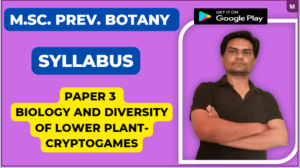![]()
Paper 5 Plant Physiology and Metabolism
Unit 1
Water relations of plants: Unique physicochemical properties of water, chemical potential, water potential, apparent free space, bulk movement of water. Soil plant Atmosphere Continuum (SPAC), stomatal regulation of transpiration, signal transduction in guard cell.
Membrane Transport : Passive non -mediated transport and ernst equation, Passive – mediated transport. ATP driven active transport, Uniport, Symport, Antiport Ion channels.
Amino acids, Proteins and Enzymes: Nod factor, root nodulation and nitrogen fixation, structure of amino acids, stereoisomers, amphoteric properties synthesis of amino acids by reductive amination, GS-GOGAT system and transamination.
Structure of Proteins: Primary, secondary, tertiary, quaternary and domain structure, reverse turn and Ramachandran Plot, protein stability: electrostatic forces, hydrogen bonding, disulfide bonding and hydrophobic interaction.
Enzyme : Structure and properties, substrate specificity, classification and mechanism of enzyme action.
Unit 2
Carbohydrates : Classification structure and function of monosaccharides, polysaccharides and glycoproteins including starch, cellulose and pectins.
Photosynthesis : Photosynthetic pigments absorption and transformation of radiant energy photo-oxidation four complexes of thylakoid membranes: Photosystem I cytochrome b, f- complex , photosystem II and coupling factors, photolysis of water and O₂evolution, non-cyclic and cyclic transportation of electrons, water-water cycle proton gradient and photophosphorylation, calvin cycle, regulation of RUBISCO activity, control of the Calvin cycle, C4 pathway and its adaptive significance, CAM pathway, differences between C3 and C4 plant glycolate pathway and photorespiration, chlororespiration and CO2 concentrating mechanism in micro – organism.
Unit 3
Respiration –Anaerobic and aerobic respiration, amphibolic nature of TCA cycle pentose phosphate pathway, glyoxylate pathway oxidative phosphorylation, gluconeogenesis, high energy compounds: their synthesis and utilisation.
Fat metabolism: Synthesis of long chain fatty acids, lipid biosynthesis and oxidation.
Secondary metabolites: Biosynthesis and function of secondary metabolites with special reference to tannins, alkaloids and steroids.
Unit 4
Plant growth regulators : Auxins – chemical nature, bioassay. Physiological effects and mode of action.
Gibberellins – Chemical nature, bioassay, physiological effects, and mode of action.
Cytokinins – Chemical nature, bioassay, physiological effects and mode of action.
Abscisic Acid- chemical nature, bioassay, physiological effects and mode of action.
Physiology of flowering : Photoperiodism and vernalization.



